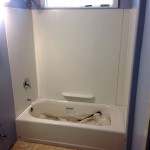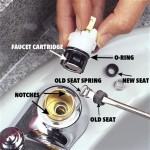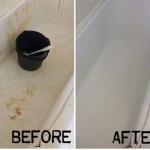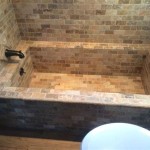Repairing a Hole in Your Bathtub Wall: A Comprehensive Guide
Holes in a bathtub wall can be a significant problem, leading to water damage, mold growth, and a compromised aesthetic. Whether caused by accidental impact, aging materials, or poorly executed renovations, addressing these holes promptly and effectively is crucial. This article provides a detailed guide to repairing holes in bathtub walls, covering various materials, methods, and preventative measures. Understanding the different types of bathtub wall materials and selecting the appropriate repair technique is key to a successful and long-lasting solution.
The task of repairing a hole might seem daunting, but with the right tools, materials, and a methodical approach, it can be a manageable DIY project. Leaving the hole unrepaired can lead to more severe complications, including structural damage to the bathroom and the potential for health hazards. Therefore, a proactive approach to repair is highly recommended.
Identifying the Bathtub Wall Material
Before beginning any repair work, accurately identifying the material of the bathtub wall is paramount. Common materials include acrylic, fiberglass, tile, and drywall (often behind tile or as a substrate for other finishes). Each material requires a specific approach and different repair products. Improperly applying the wrong repair method can exacerbate the problem, leading to further damage and a less aesthetically pleasing result.
Acrylic: Acrylic bathtub walls are known for their smooth, non-porous surface and resistance to staining. They are often durable but can be susceptible to cracking or puncturing from sharp impacts. Repairs to acrylic typically involve patching with acrylic-based fillers or repair kits specifically designed for the material. The repair needs to blend seamlessly with the existing surface to maintain its appearance and waterproof seal.
Fiberglass: Fiberglass is a lightweight yet strong material commonly used in bathtubs and surrounding walls. It can be prone to cracking or denting under pressure. Repairing fiberglass often involves using a fiberglass repair kit consisting of resin, hardener, and fiberglass cloth. The cloth reinforces the damaged area, while the resin and hardener create a durable and waterproof bond.
Tile: Tile is a popular choice for bathtub walls due to its water resistance and aesthetic appeal. However, tiles can crack or chip, leaving unsightly holes. Repairing tile involves replacing the damaged tile with a new one of the same size, color, and pattern. This may require removing grout, applying adhesive, and then re-grouting the new tile to create a watertight seal.
Drywall: Drywall, while not typically used as a primary surface in the immediate shower or tub enclosure, often forms the wall structure behind tile or other finishes. If there's a hole in the tile or the surface finish is compromised, water can penetrate and damage the drywall behind it. Repairing drywall involves removing the damaged section, installing new drywall, taping the seams, applying joint compound, sanding, and painting. If moisture damage is present, addressing the underlying cause of the leak is crucial before repairing the drywall.
Essential Tools and Materials
The specific tools and materials needed will depend on the type of bathtub wall and the size and nature of the hole. However, some common essentials include:
Safety Gear: Safety glasses, gloves, and a dust mask are essential to protect yourself from debris, chemicals, and potential irritants during the repair process.
Cleaning Supplies: A cleaner to remove dirt, grime, and mildew from the damaged area is necessary to ensure proper adhesion of repair materials. Isopropyl alcohol can also be used to degrease the surface.
Patching Materials: These will vary depending on the material being repaired. For acrylic and fiberglass, specialized repair kits are available. For drywall, joint compound (also known as "mud") and drywall tape are needed. For tile, you'll need replacement tile, thin-set mortar (adhesive), grout, and a grout float.
Tools for Cutting and Shaping: Utility knife, drywall saw, or multi-tool are useful for removing damaged material and shaping patches. For tile repair, a grout saw or rotary tool with a grout removal bit is necessary.
Tools for Application and Smoothing: Putty knife, drywall knife, sandpaper (various grits), and a sponge are needed for applying patching materials, smoothing surfaces, and cleaning up excess material.
Adhesives and Sealants: Waterproof caulk or sealant is crucial for creating a watertight seal around the repaired area and preventing future water damage. For tile, thin-set mortar is used to adhere the tile to the wall.
Painting Supplies: Primer and paint that match the existing color and finish of the bathtub wall are necessary for blending the repaired area seamlessly.
Step-by-Step Repair Procedures
The repair process varies significantly depending on the type of bathtub wall and the extent of the damage. The following sections outline generalized procedures for repairing common types of bathtub wall materials.
Repairing a Hole in Acrylic or Fiberglass:
- Prepare the Area: Clean the damaged area thoroughly with soap and water, then degrease with isopropyl alcohol. Remove any loose or jagged edges with a utility knife or sandpaper.
- Apply Patching Material: Follow the instructions on the acrylic or fiberglass repair kit. Typically, this involves mixing a resin and hardener and applying it to the damaged area. For larger holes, you may need to use fiberglass cloth to reinforce the patch.
- Sand and Smooth: Once the patching material has cured, sand the surface smooth using progressively finer grits of sandpaper. Feather the edges of the patch to blend seamlessly with the surrounding surface.
- Finish and Seal: Apply a color-matched acrylic or epoxy paint to the repaired area. Once the paint is dry, apply a bead of waterproof caulk around the perimeter of the patch to create a watertight seal.
Repairing a Hole in Tile:
- Remove Damaged Tile and Grout: Carefully remove the damaged tile using a grout saw or rotary tool with a grout removal bit. Be careful not to damage the surrounding tiles.
- Clean the Area: Remove any debris or old adhesive from the wall behind the tile. Ensure the surface is clean and dry.
- Apply Thin-Set Mortar: Apply a thin, even layer of thin-set mortar to the back of the new tile and to the wall where the tile will be placed.
- Set the Tile: Press the new tile firmly into place and ensure it is level with the surrounding tiles. Use tile spacers to maintain consistent grout lines.
- Grout the Tile: Allow the thin-set mortar to cure completely according to the manufacturer's instructions. Then, apply grout to the grout lines using a grout float. Remove excess grout with a damp sponge.
- Seal the Grout: After the grout has cured, apply a grout sealer to protect it from moisture and stains.
Repairing a Hole in Drywall (Behind Tile or Other Finish):
- Assess the Damage: Carefully remove loose or damaged drywall around the hole. If the hole is small, you may be able to patch it directly. For larger holes, you may need to cut away a larger section of drywall to create a clean, rectangular opening.
- Install Backing (If Necessary): For larger holes, install wood backing behind the drywall to provide support for the patch. Screw or glue the backing to the existing studs or framing.
- Cut and Install Drywall Patch: Cut a piece of drywall to fit the opening. Apply joint compound to the edges of the opening and the back of the patch. Press the patch firmly into place and secure it with drywall screws.
- Tape and Mud: Apply drywall tape over the seams between the patch and the existing drywall. Apply multiple thin coats of joint compound over the tape and screws, feathering the edges to blend seamlessly with the surrounding surface. Allow each coat to dry completely before applying the next.
- Sand and Prime: Once the joint compound is completely dry, sand the surface smooth using progressively finer grits of sandpaper. Prime the patched area with a drywall primer.
- Paint: Paint the patched area with a paint that matches the existing wall color and finish.
It is crucial to remember that when repairing drywall behind tile, addressing any underlying moisture problems is the first and most important step. Ignoring existing leaks will lead to the drywall damage recurring.
These are generalized procedures, and specific steps may vary depending on the product and the extent of the damage. Always refer to the manufacturer's instructions for the patching materials you are using.

How To Fix A Hole In Bathtub Fiberglass

How To Repair A Hole In Fiberglass Bathtub Surround

Fix A Large Hole In Fiberglass Shower

Fiberglass Bathtub Repair Small Wall

Diy How To Repair A In Bath Tub Or Wall

S Chips And Holes Diy Bathtub Shower Repair Tips

How To Fix Large Hole In Fiberglass Tub

Repair Caulk Grout And Drywall In A Weekend

14 1 2 In W X 32 L Bathtub Floor Repair Inlay Kit White Wt 1432 The Home Depot

14 1 2 In W X 32 L Bathtub Floor Repair Inlay Kit White Wt 1432 The Home Depot
Related Posts








